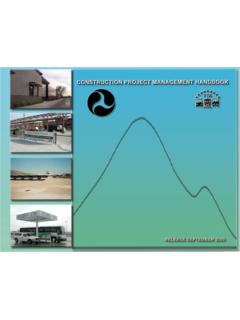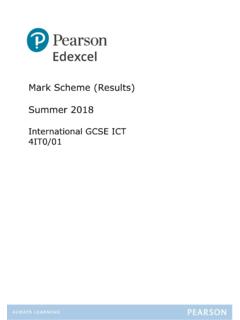Transcription of Mark Scheme (Results) - Edexcel
1 Mark Scheme ( results ) Summer 2018 Pearson Edexcel GCE In Biology Spec A (9BN0) Paper 02 Energy, Exercise and Coordination Edexcel and BTEC Qualifications Edexcel and BTEC qualifications come from Pearson, the world s leading learning company. We provide a wide range of qualifications including academic, vocational, occupational and specific programmes for employers. For further information visit our qualifications websites at or for our BTEC qualifications. Alternatively, you can get in touch with us using the details on our contact us page at If you have any subject specific questions about this specification that require the help of a subject specialist, you can speak directly to the subject team at Pearson. Their contact details can be found on this link: You can also use our online Ask the Expert service at You will need an Edexcel username and password to access this service. Pearson: helping people progress, everywhere Our aim is to help everyone progress in their lives through education.
2 We believe in every kind of learning, for all kinds of people, wherever they are in the world. We ve been involved in education for over 150 years, and by working across 70 countries, in 100 languages, we have built an international reputation for our commitment to high standards and raising achievement through innovation in education. Find out more about how we can help you and your students at: Summer 2018 Publications Code 9BN0_02_1806_MS All the material in this publication is copyright Pearson Education Ltd 2018 General Marking Guidance All candidates must receive the same treatment. Examiners must mark the first candidate in exactly the same way as they mark the last. Mark schemes should be applied positively. Candidates must be rewarded for what they have shown they can do rather than penalised for omissions. Examiners should mark according to the mark Scheme not according to their perception of where the grade boundaries may lie.
3 There is no ceiling on achievement. All marks on the mark Scheme should be used appropriately. All the marks on the mark Scheme are designed to be awarded. Examiners should always award full marks if deserved, if the answer matches the mark Scheme . Examiners should also be prepared to award zero marks if the candidate s response is not worthy of credit according to the mark Scheme . Where some judgement is required, mark schemes will provide the principles by which marks will be awarded and exemplification may be limited. When examiners are in doubt regarding the application of the mark Scheme to a candidate s response, the team leader must be consulted. Crossed out work should be marked UNLESS the candidate has replaced it with an alternative response. Mark schemes will indicate within the table where, and which strands of QWC, are being assessed. The strands are as follows: i) ensure that text is legible and that spelling, punctuation and grammar are accurate so that meaning is clear ii) select and use a form and style of writing appropriate to purpose and to complex subject matter iii) organise information clearly and coherently, using specialist vocabulary when appropriateUsing the Mark Scheme Examiners should look for qualities to reward rather than faults to penalise.
4 This does NOT mean giving credit for incorrect or inadequate answers, but it does mean allowing candidates to be rewarded for answers showing correct application of principles and knowledge. Examiners should therefore read carefully and consider every response: even if it is not what is expected it may be worthy of credit. The mark Scheme gives examiners: an idea of the types of response expected how individual marks are to be awarded the total mark for each question examples of responses that should NOT receive credit. / means that the responses are alternatives and either answer should receive full credit. ( ) means that a phrase/word is not essential for the award of the mark, but helps the examiner to get the sense of the expected answer. Phrases/words in bold indicate that the meaning of the phrase or the actual word is essential to the answer. ecf/TE/cq (error carried forward) means that a wrong answer given in an earlier part of a question is used correctly in answer to a later part of the same question.
5 Candidates must make their meaning clear to the examiner to gain the mark. Make sure that the answer makes sense. Do not give credit for correct words/phrases which are put together in a meaningless manner. Answers must be in the correct context. Quality of Written Communication Questions which involve the writing of continuous prose will expect candidates to: write legibly, with accurate use of spelling, grammar and punctuation in order to make the meaning clear select and use a form and style of writing appropriate to purpose and to complex subject matter organise information clearly and coherently, using specialist vocabulary when appropriate. Full marks will be awarded if the candidate has demonstrated the above abilities. Questions where QWC is likely to be particularly important are indicated (QWC) in the mark Scheme , but this does not preclude others. Question Number Answer Additional Guidance Mark 1(a)(i) A description that makes reference to two of the following: carrier protein (in cell surface membrane) (1) (glucose moves from) high to low concentration (1) glucose binds to (carrier) protein / (carrier) protein changes shape to move glucose (across the membrane) (1) IGNORE channel protein ALLOW down a concentration gradient (2) Question Number Answer Additional Guidance Mark 1(a)(ii) An explanation that makes reference to three of the following.
6 Polymer of glucose (1) to provide glucose for respiration (1) {branched / contains 1,6-glycosidic bonds / has many terminal ends} for rapid hydrolysis (1) compact to allow large amount (of glucose / energy) to be stored in a small space / insoluble therefore no osmotic effect on cells (1) ALLOW polysaccharide /made of many glucose monomers DO NOT ALLOW - glucose IGNORE easy to hydrolyse ALLOW break down instead of hydrolyse (3) Question Number Answer Additional Guidance Mark 1(b) An explanation that makes reference to the following: interaction between transcription factors and promoter (region on gene) (1) RNA polymerase binds (to promoter region) (1) { transcription /mRNA produced } (for insulin gene) (1) ALLOW regulatory instead of promoter or reference to transcription initiation complex ALLOW transcription initiation complex binds (to promoter region) if RNA polymerase described as part of the complex (3) Question Number Answer Mark 2(a)(i) C location of a gene on a chromosome The only correct answer is C A is incorrect because locus is not the genetic code for a protein B is incorrect because a centromere holds together sister chromatids and not a locus D is incorrect because a locus is not the paternal part of a genome (1) Question Number Answer Additional Guidance Mark 2(a)(ii)
7 An answer that makes reference to three of the following: Similarities both have a carboxylic acid group (1) both have { hydrocarbon chains / chains formed from only hydrogen and carbon } (1) Differences saturated fatty acids have { no carbon to carbon double bonds / only have carbon to carbon single bonds } (1) saturated fatty acids are straight chains and unsaturated fatty acids have { bent chains / a kink in the chain } (1) ALLOW annotated diagrams used show similarities and differences ALLOW COOH ALLOW description of hydrocarbon chains ALLOW converse for unsaturated fatty acids (3) Question Number Answer Additional Guidance Mark 2(b) An answer that makes reference to the following: { FTOT / saturated fat diet } is associated with increased BMI (1) FTOT (allele) is recessive / FTOC (allele) is dominant (1) highest increase in BMI was for individuals homozygous for FTOT on a saturated fat diet (1) ALLOW FTOT FTOT genotype (3) Question Number Answer Additional Guidance Mark 3(a) An explanation that makes reference to three of the following: { warm conditions / water / glucose / amino acids / ideal pH } available (1) Plus 2 of the following.
8 Suitable { temperature / pH } for bacterial enzymes (1) glucose used for {respiration / energy} (1) amino acids used for growth (1) ALLOW 37 C ALLOW optimum (3) Question Number Answer Additional Guidance Mark 3(b) An explanation that makes reference to two of the following: lumen of capillaries blocked (1) preventing supply of {oxygen / glucose} (to tissues or cells ) (1) therefore respiration stops (and tissues die) / anaerobic respiration causes build-up of lactic acid (1) ALLOW build-up of carbon dioxide (2) Question Number Answer Additional Guidance Mark 3(c)(i) An explanation that makes reference to two of the following: tendons attach muscles to bones (1) (flexor and extensor) muscles act as an antagonistic pair (1) when the {extensor muscle contracts, it pulls on the tibia to extend the leg / flexor muscle contracts, it pulls on the fibula flexing the leg} (1) ALLOW marks for correctly annotated diagram ALLOW reference to a tendon attaching a named muscle to a named bone ALLOW quadriceps for extensor and hamstring for flexor (2) Question Number Answer Additional Guidance Mark 3(c)(ii) the muscles are still attached to (bones in) the lower leg and the prosthetic limb is attached to the lower leg (allowing movement) ALLOW reference to tibia and/or fibula instead of lower leg.
9 No marks if reference made to muscle attachment to prosthetic limb. (1) Question Number Answer Mark 4(a)(i) C - retinal The only correct answer is C A is incorrect because IAA is auxin B is incorrect because opsin is the protein part and not the non-protein D is incorrect because rhodopsin is the pigment (1) Question Number Answer Mark 4(a)(ii) A The only correct answer is A B is incorrect because it is the hypothalamus C is incorrect because it is the medulla oblongata D is incorrect because it is the cerebellum (1) Question Number Answer Additional Guidance Mark 4(a)(iii) An explanation that makes reference to the following: (fMRI) detects { blood flow / oxygen use } in the brain (1) increased brain activity results in increased { blood flow / demand for oxygen / aerobic respiration } in the area of activity (1) oxyhaemoglobin absorbs fewer radio waves / fMRI detects areas where less signal absorbed (1) ALLOW signal reflected by oxyhaemoglobin (3) Question Number Answer Additional Guidance Mark 4(b) A description that makes reference to three of the following.
10 Ocular dominance columns (develop in visual cortex) (1) neurones form synapses with these { cells / columns } (1) { stimuli / action potentials / impulses } along neurones required to strengthen connections (with cells of ocular dominance columns) (1) stimulation during the critical period is needed to form (effective) connections in the visual cortex (1) ALLOW columns of (target) cells ALLOW more synapses for stronger connections OR connections become weaker if stimuli not received (3) Question Answer Additional Guidance Mark Number 5(a) A description that makes reference to four of the following: thermoreceptors (in hypothalamus or skin) detect increase in temperature (1) { heat loss / thermoregulatory } centre in hypothalamus stimulated (1) (hypothalamus) sends impulses to sweat glands (1) increased blood flow to surface of skin by {vasodilation / constriction of shunt vessels} (1) decreased metabolic rate (1) ALLOW impulses sent to thermoregulatory centre in hypothalamus ALLOW action potential IGNORE dilation of capillaries (4) Question Number Answer Additional Guidance Mark 5(b) An answer that makes reference to the following.











